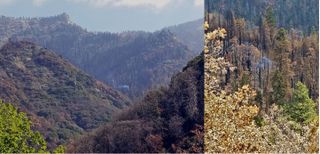Giant sequoia tree still smoldering 9 months after devastating California wildfires
The tree was still burning from the 2020 Castle Fire.

A giant sequoia tree in California's Sequoia National Park is still smoldering months after devastating wildfires hit the region last summer.
Scientists recently found the tree while surveying the park to determine the effects of the 2020 Castle Fire, according to a statement from the National Park Service. The tree, which is located in Board Camp Grove and has no direct trail access, was observed "still smoldering and smoking," most likely from the 2020 fires, the statement said.
Sparked by a lightning strike in August 2020, the Castle Fire eventually burned about 150,000 acres (60,700 hectares) before it was contained in December 2020, according to The Guardian.
However, embers inside this particular tree continued to smolder despite winter rain and snow, The Guardian reported. This persistent burning isn't necessarily unusual — it's known that after intense fires, some trees will continue to slowly burn, as the inside of the tree provides an oxygen-rich environment and shelter for the fire, according to The Guardian. But such a phenomenon is unusual for sequoia trees, which are well adapted to fire and have fire-resistant bark, according to National Geographic.
"The fact [that] areas are still smoldering and smoking from the 2020 Castle Fire demonstrates how dry the park is," Leif Mathiesen, assistant fire management officer for Sequoia & Kings Canyon National Parks, said in the statement.
The dry conditions do not bode well for this year's fire season — which peaks some time between July and November — and authorities have already planned some controlled fires as a way to reduce the buildup of brush to prevent massive wildfires, according to CNN.
Originally published on Live Science.
Sign up for the Live Science daily newsletter now
Get the world’s most fascinating discoveries delivered straight to your inbox.

Rachael is a Live Science contributor, and was a former channel editor and senior writer for Live Science between 2010 and 2022. She has a master's degree in journalism from New York University's Science, Health and Environmental Reporting Program. She also holds a B.S. in molecular biology and an M.S. in biology from the University of California, San Diego. Her work has appeared in Scienceline, The Washington Post and Scientific American.
Most Popular



